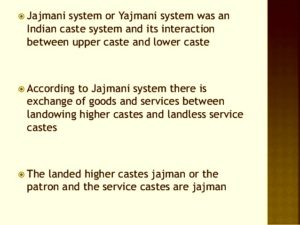The jajmani system has evolved from the word Jajman which means upper caste people. William H Wiser was the first one to introduce the term Jajmani system in which it clearly describes how different castes interact with each other for the agricultural and economic process. The landowners or Jamindars are popularly known as Jajman whereas the occupational castes are known as Kameen.

Function of Jajman and Kameen
Jajmans are mainly people who appointed Brahmins to perform religious worships and were obliged to pay them a portion of the money to them. Kameens are those who were low caste people and were appointed because some of the tasks can be performed by them only and it was considered impure by other castes, for example, hair cutting, toilet cleaning etc.
DEFINITIONS OF JAJMANI SYSTEM:-
According to Harold Gould, the Jajmani system is inter-relation of Jajmans(patrons) and Kameen(occupational castes) for the sake of maintaining an economic and religious equilibrium. It is basically a mutual relation between the sub-ordinate and super-ordinate power of society. He also mentioned a strange concept where not only Kameen are obliged to work for patrons for financial support, but in Kameen too Jajmani system prevails. They also make groups in which the lower division is bound to work for their superior people for food or financial expenses.
For the Jajmani system, Functionalist and Conflict Theories have just opposite views on this system. Functionalist theory, on one hand, saw Jajmani system as a natural process to maintain an order of harmony, unity, and discipline. On the other hand, Marxist has a different view that this system is exploiting occupational workers in the name of cultural and financial exchange. He firmly believed that if in future, condition and place of lower caste improve then there will be the possibility of open conflict. Oscar Lewis who was also a popular sociologist also agreed with a Marxist view instead of Functionalist Theory. Other sociologists like Harold Gould and Pauline Kolenda were in favor of both the ideologies. They agreed that there is a needed arrangement which takes place due to religious or economic order but at the same place it slowly has developed an exploiting nature for the Kameen. Leach, another scholar believed that the Jajmani system division is a function of caste.
CHARACTERISTICS OF JAJMANI SYSTEM:-
- A Jajman cannot remove a Kameen according to his will, which clearly means that there is a job security of Kameen for his coming generations too.
- Inheritance is the keyword for Jajman that is their rights and duties comes under ascribed status.
- There is not always the cash payment to Kameen for his work, instead, there is a payment done in the form of things which is needed by the occupational servants. This system was popularly known as Barter System where the Jajman duty was to take care of Kameen needs.
- Somehow it increases the bond between Jajman and Kameen, which follows the Functionalist view of a society. There is more emotional bond than a financial bond between these two categories.
